
At the Lacquer Chest, her fabled antiques shop in Kensington Church Street, Gretchen Andersen has a ringside seat from which to monitor and influence the shifting sands of our changing taste in things. When she started out, interiors magazines had yet to be invented. She took the shop over from her mother in law who’d had it since the end of the war, and came from a grand Anglo-Indian family. ‘In those days wonderful things were available. And then she gave up because, she said, there were no antiques left. Then Vivian my husband [who died in 2013] said, You’re very good at beginning things, but not very good at finishing. So he gave up his job with Ove Arup, and we began working together. We’ve been there over 60 years as well. ‘

Gretchen understands the flows and ebbs of antique dealing with the same keen intelligence of a trawler-skipper working the seabed and its teeming populations. Charlie Porter of @tat.london rates @lacquerchest as a TOP SHOP and so does @theworldofinteriors – with a feature on Gretchen’s London House published a month ago that has segued into this one, when I returned for more talking and more photographs. ‘Unlike most shops, at the Lacquer Chest, you never know what’s going to be there.’ Gretchen told me. ‘It’s best if you please yourself, but if I liked something, I’d get seduced and I would always buy it and I don’t think that’s a very good way to deal. But it’s perfectly obvious – via Instagram – that most people just want to be like other people, there are a few who do just what they want, but that’s very unusual.’
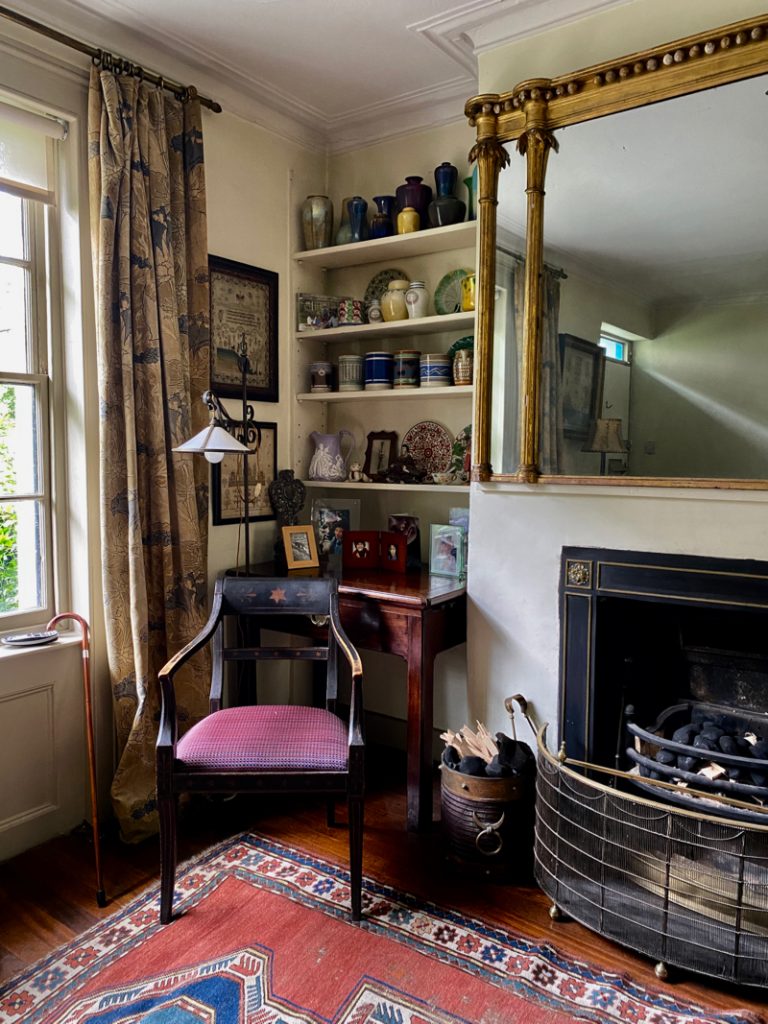
‘If I was in the shop I would deal with the customers because I knew them, so I made lots of friends. I met such interesting people, only one in all those years who sent me running into the back of the shop – and he was a famous dealer.
I remember going to so many houses and saying, My God that ‘s wonderful! Where did you get it? And they said, We got it from you! Those Mochaware mugs have come down from the hiring department, 20 years ago we hired them out a lot. They’re just out of fashion. Hiring has taught us a lot about fashion.’
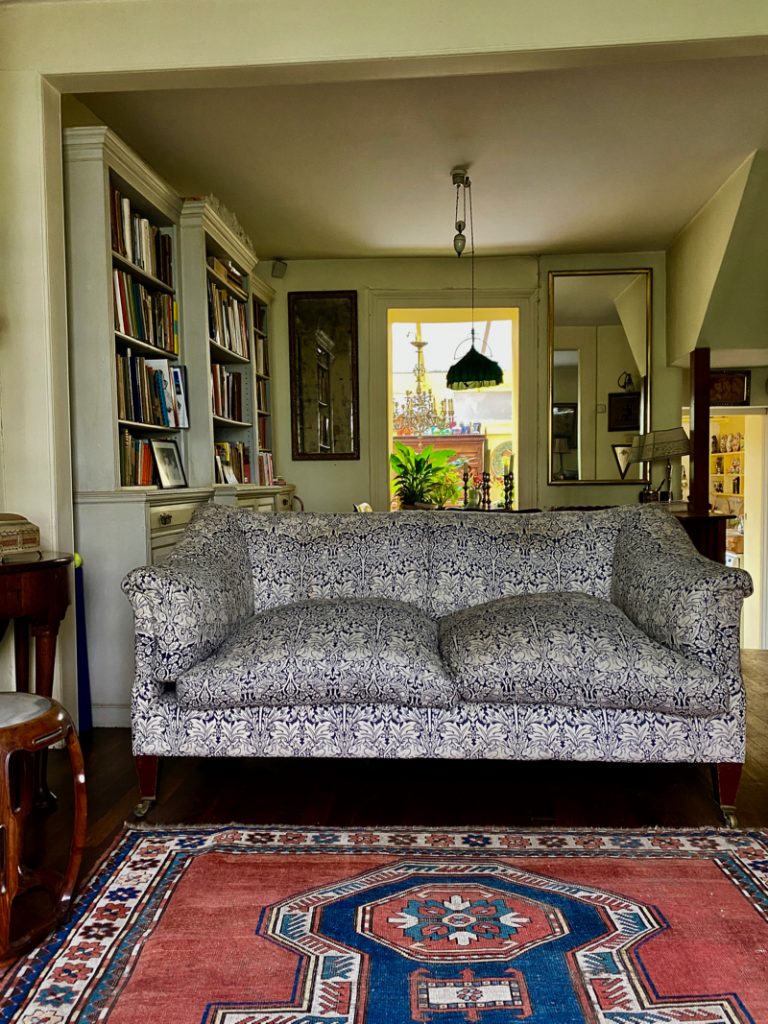
‘I knew all the people who worked for Terence Conran, his buyers. When he was young, he came into the shop and said, I’ve bought a small company that makes chairs, and if you find a chair that’s worth copying please let me know. I was very flattered.
I thought Sir Roy Strong was a very, very clever man. I watched his progress, his garden exhibition at the V and A – it was wonderful! Theatrical. As I left, I thought, Gardens are never going to be the same – and now people are obsessive about them! That’s a Howard sofa, I bought it because it was so comfortable, to replace a Chesterfield, 60 years ago, I only found out the maker’s name later on.’
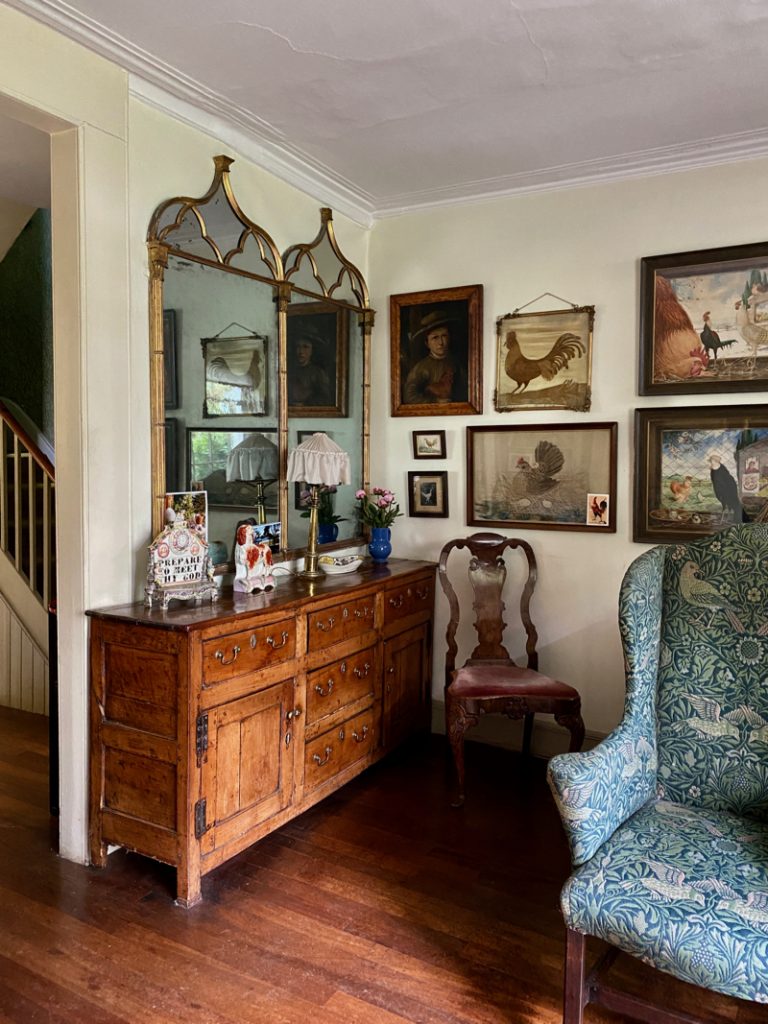
‘That’s real Morris. I got it 50 years ago, nobody knew what it was.’

‘A boy who used to work for us painted that table. I know at least two people who’ve inherited their father’s Regency furniture and its looks ghastly in their houses ,and you think – Why? ‘
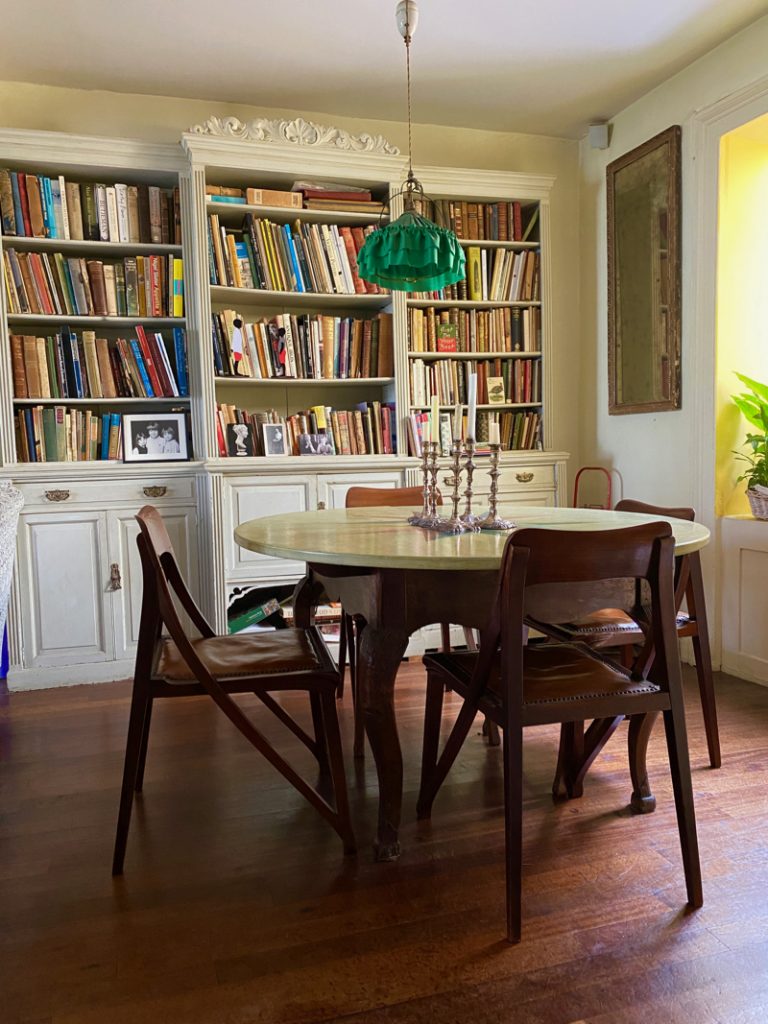
‘I’ve just read a book again that I read about 10 years ago, about the Garlands – Kathleen [Garland], Lady Epstein, one of Epstein’s many mistresses, she stayed the course and had three children by him – She bought a kitchen table from us.
The dining room was the thing then, but we had one big room that was our kitchen and our dining room. Within ten years the dining room had ceased to be a thing. Do you have a dining room?’

‘It is hard for a husband and a wife to work together. I always felt so guilty, because I worked so hard, I really wanted to bring up my children. I used to come home and eat lunch with them every day and I was an obsessive cook.’
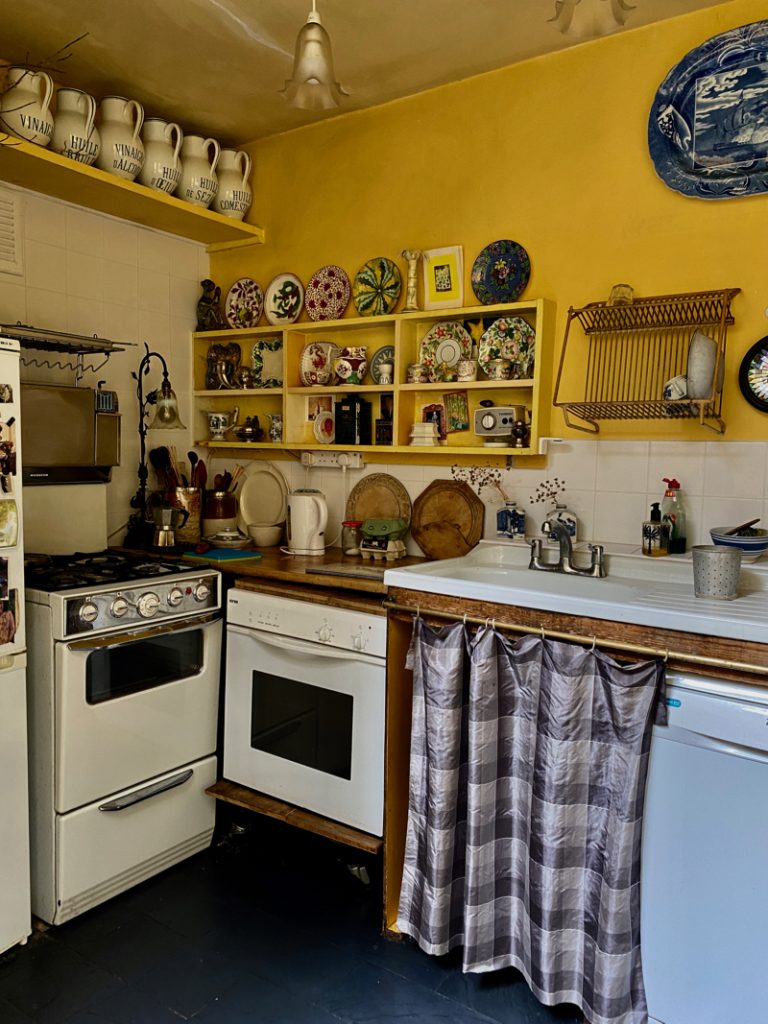
‘We had a tiny kitchen up to here.
We rebuilt it about 30 years ago.’

‘Viv had a very good eye and bought some wonderful things. I was much the bigger buyer, so I was out three days and Viv was out perhaps one or two. I used to go to Scotland every month – everywhere – I used to take the car to Olympia, put it on the train and get out at Perth. Well, I loved it! I used to go to the west country every week. Once the M5 came and Gloucestershire became so grand, it was not so easy. We never looked up things when we bought them privately which meant we always sold things at a bargain.’

‘We’ve lived here for over 62 years.’
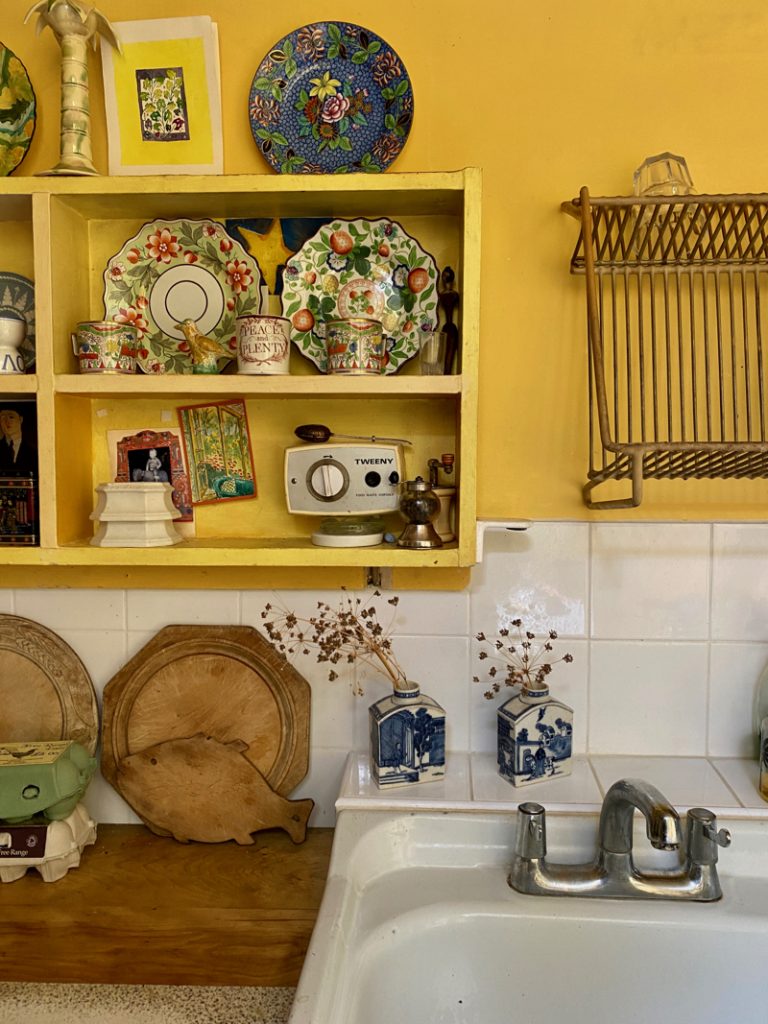
‘Antiques were considered only before 1830. We were buying what other people left behind. I was an avid reader of Vogue and I followed Elizabeth David – casseroles, wooden spoons and bread boards – and I bought all that sort of thing. And then I remember suddenly realising the word ‘lifestyle’ had entered into society,’ she says.
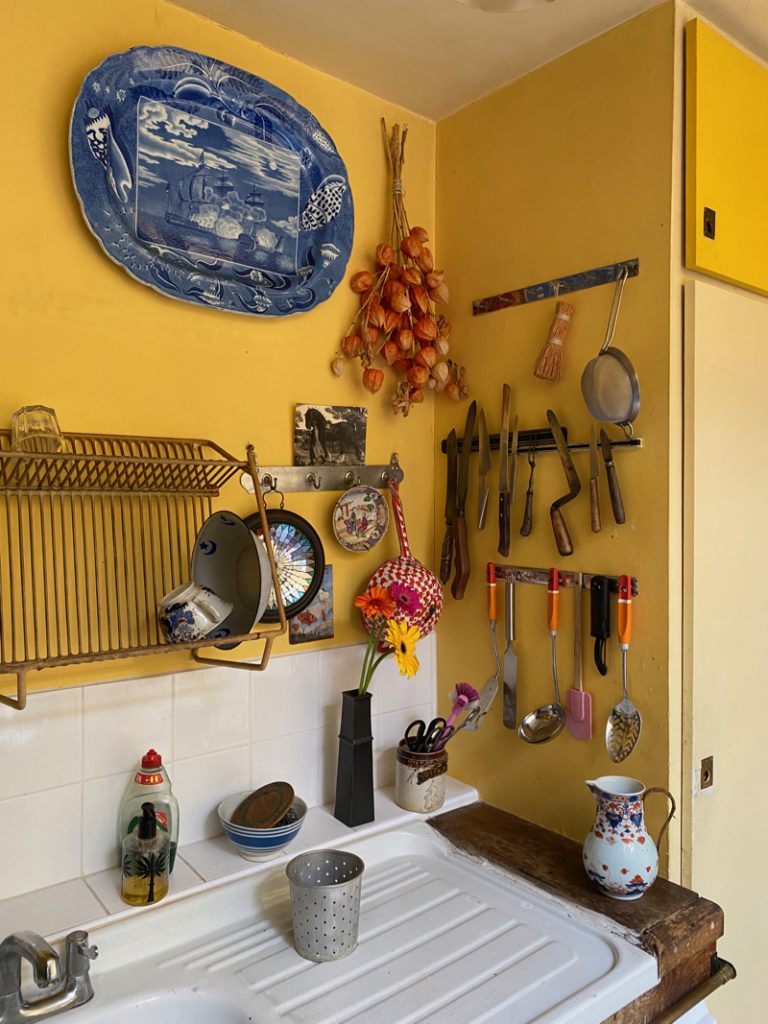
‘What is so awful is that almost everything I collected – like samplers and blue and white china – is unthinkable now.’
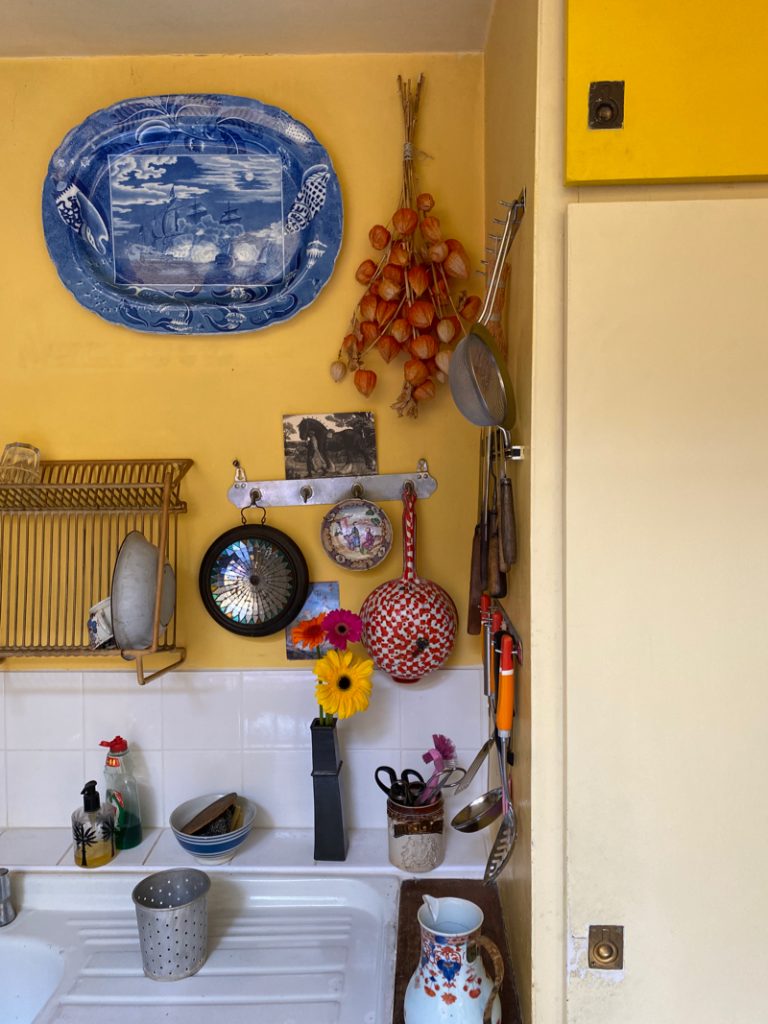
The knocked-through kitchen is a light-box painted by a man whom she describes as a difficult genius, a colourist who used nine different yellows and added a single muted lavender stripe to one ceiling rafter.
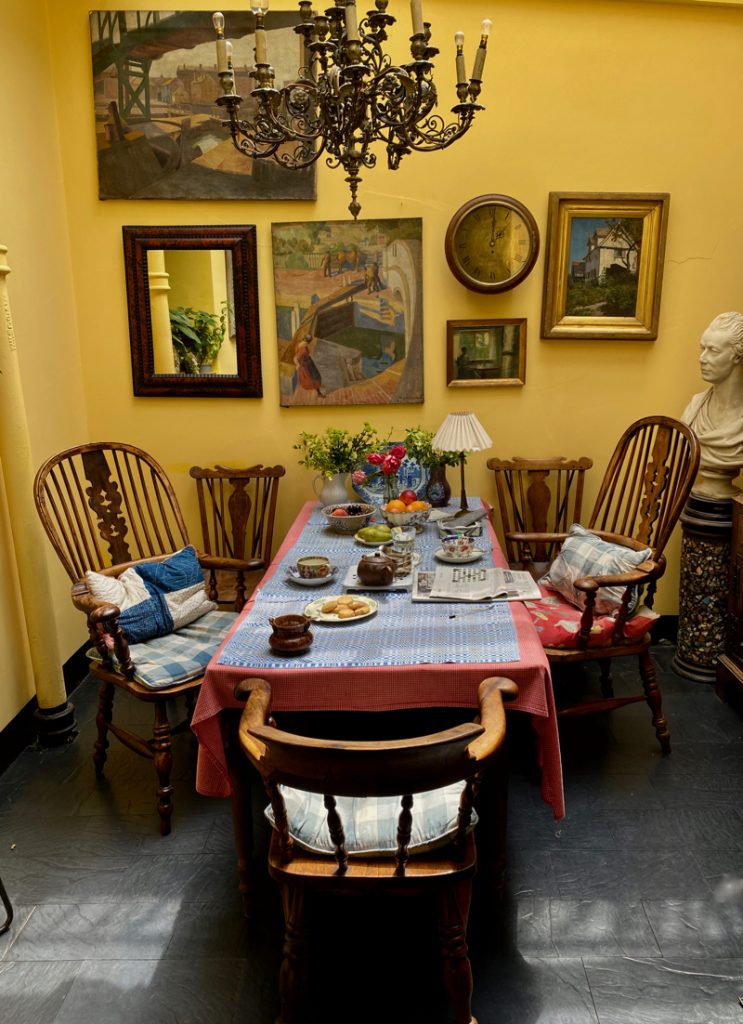
‘Near our Sussex house there was a woman from a very artistic family. And they had a studio down on the river. She asked Vivian to come, they were clearing it out. Outside there was a skip, and next to it there was that. She said. Oh those are rubbish, my sister painted them.’

‘Hockney bought from us when he was a student, just useful things, armchairs and things. Julie Christie used to come for at least 5 years, buying furniture.Then she just disappeared. Min Hogg bought a huge bed from us. She’d just come in and say, I love it! I’ll have it, please deliver it.’
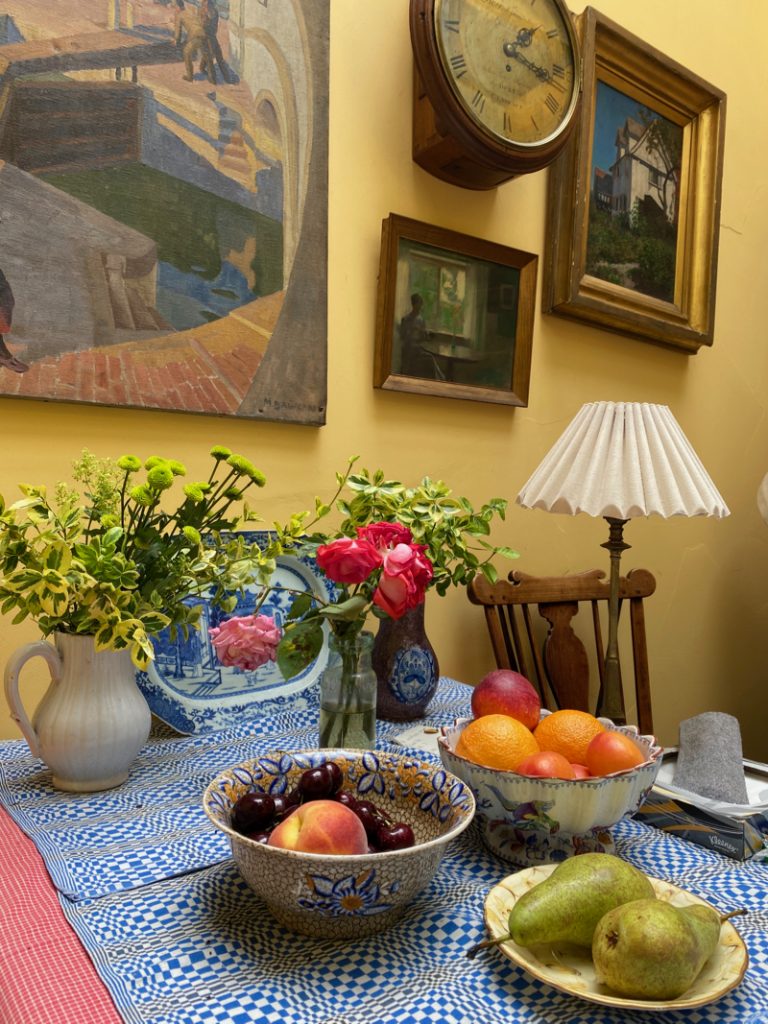
‘That Delft pot? I bought it years ago, it had a broken handle and I had it ground off. It’s sad that almost anything old is better than anything new. It’s really hard when you buy things, to know which are the winners. Even after all those years – you should know. I bought the most beautiful thing, a Green Man by Prue Piper.
I sold it to someone who I think knew what it was. That picture there – I bought to sell – in a shop in Marlborough. Oh I loved her!
I bought it for a fiver.
It’s so peaceful.’
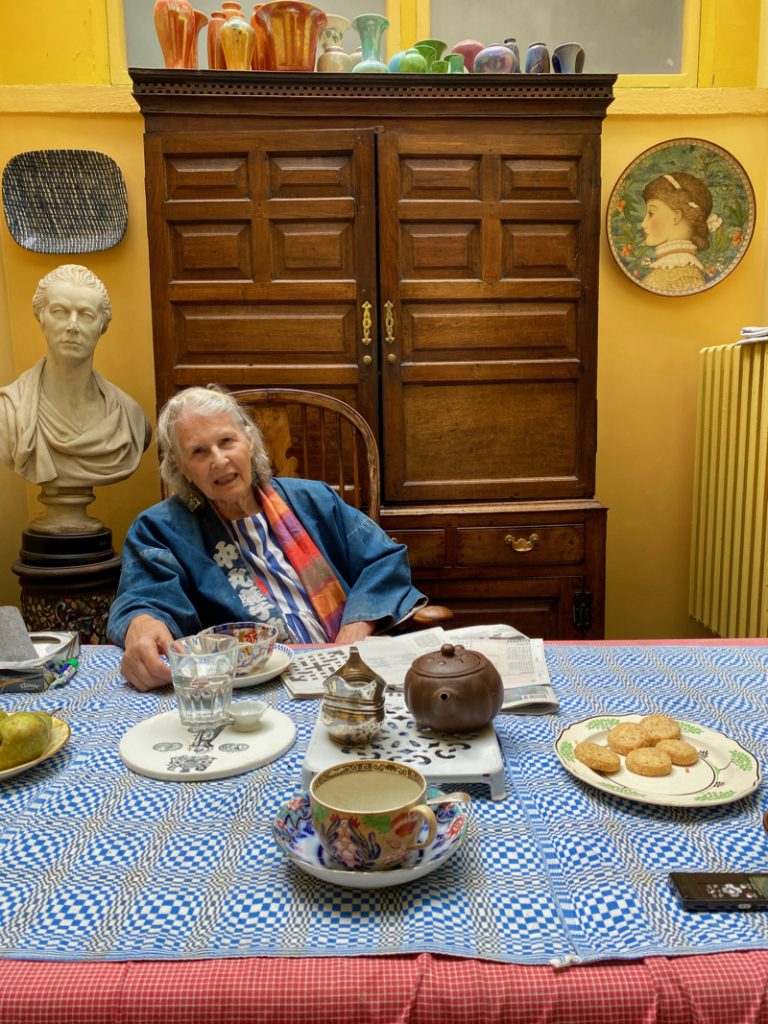
‘This is the nicest, lightest, room, I live in here. That teapot cost about £10, from a shop selling tea, in China – I went there with a friend who wrote the Blue Guide. I’ve always lived on Lapsang. I made this mismatched set of breakfast cups. The tablecloth? Its English, I pulled it out of the hiring department. That’s something called Ruskin ware, Ive got masses of it, its very hard to sell.’

‘There’s no real problem about finding out about things in England with all these marvelous museums – Maybe if you lived in Australia there would be – you just have to go and open your eyes and look!’


‘I had this man’s dressing gown in hiring and it never hired, so it’s been lined for me to wear.’
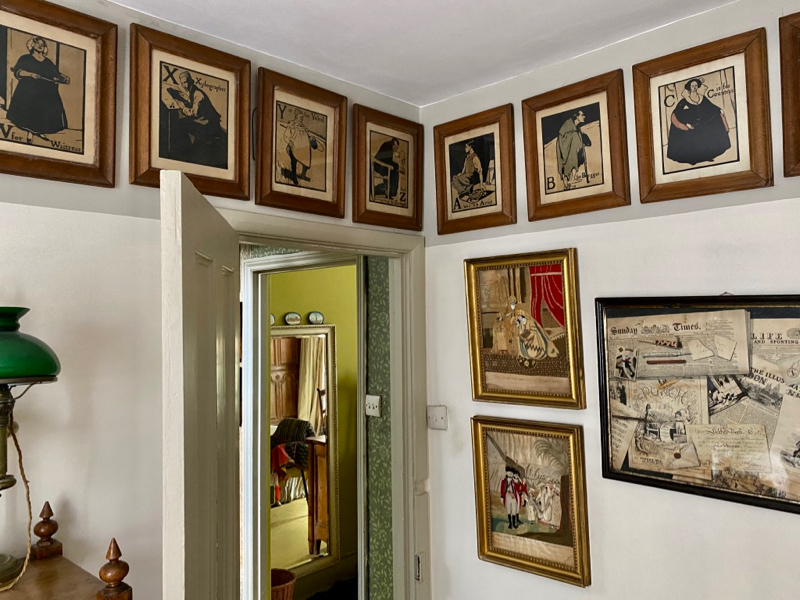
Alphabet lithographs by William Nicholson.

staircase corner

ablutions
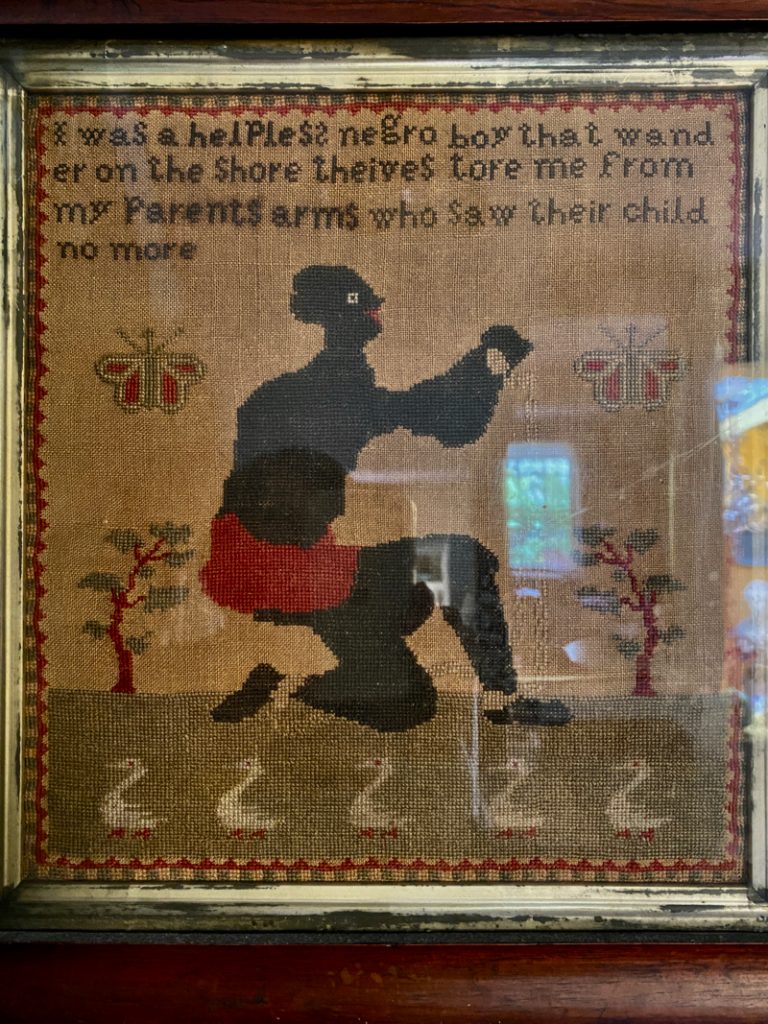
abolition sampler
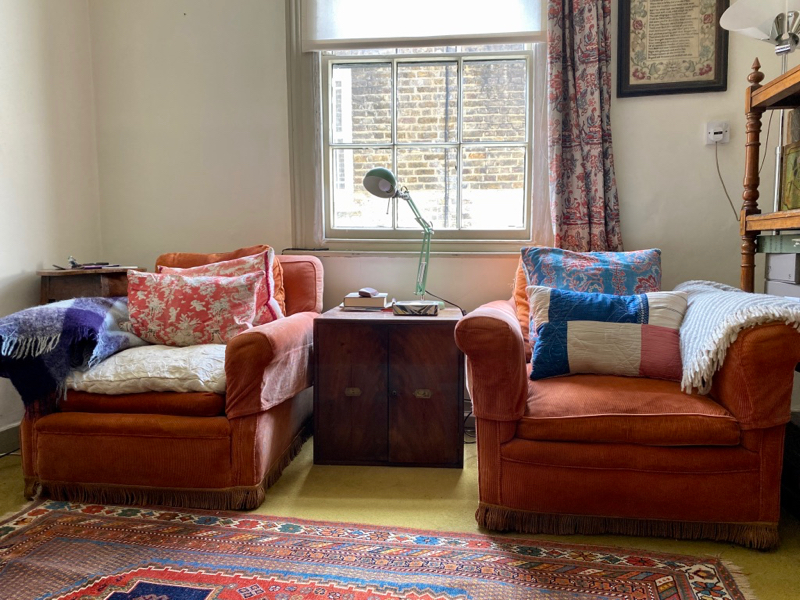
The orange corduroy chairs? – I sold the matching corduroy sofa to Lord Snowdon’s second wife.
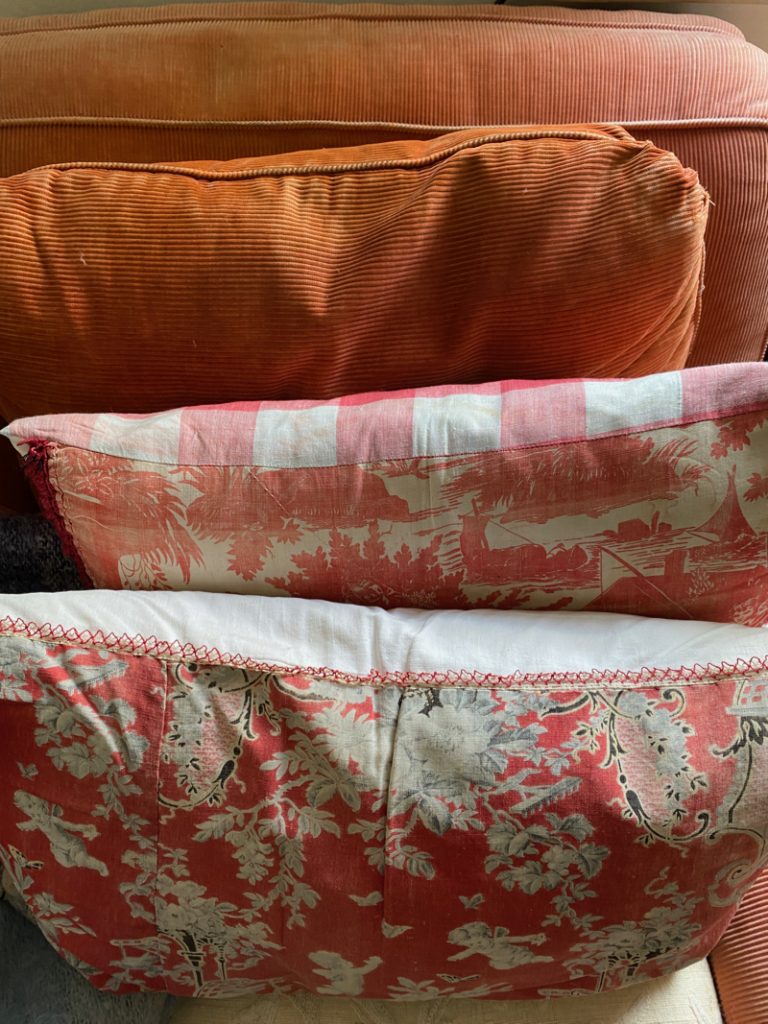
cushions

cushions
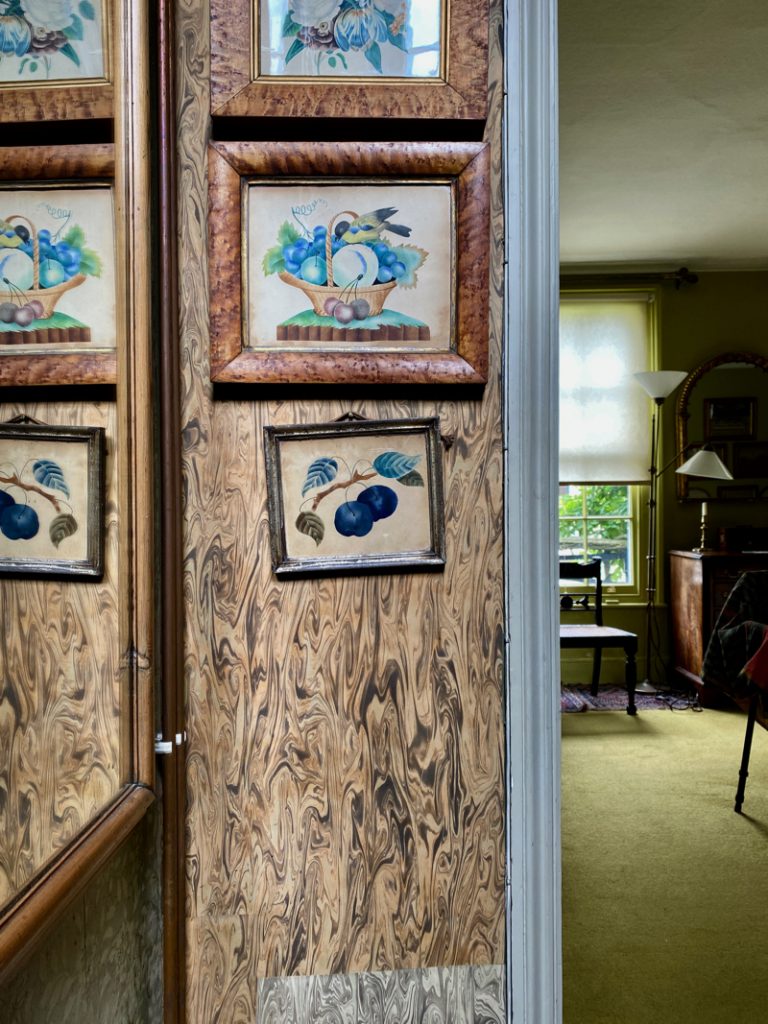
‘I can remember a customer coming and showing this wallpaper to me and saying the people who made it were closing down. And I rushed into the west end, and bought it. It was three shillings a roll.’
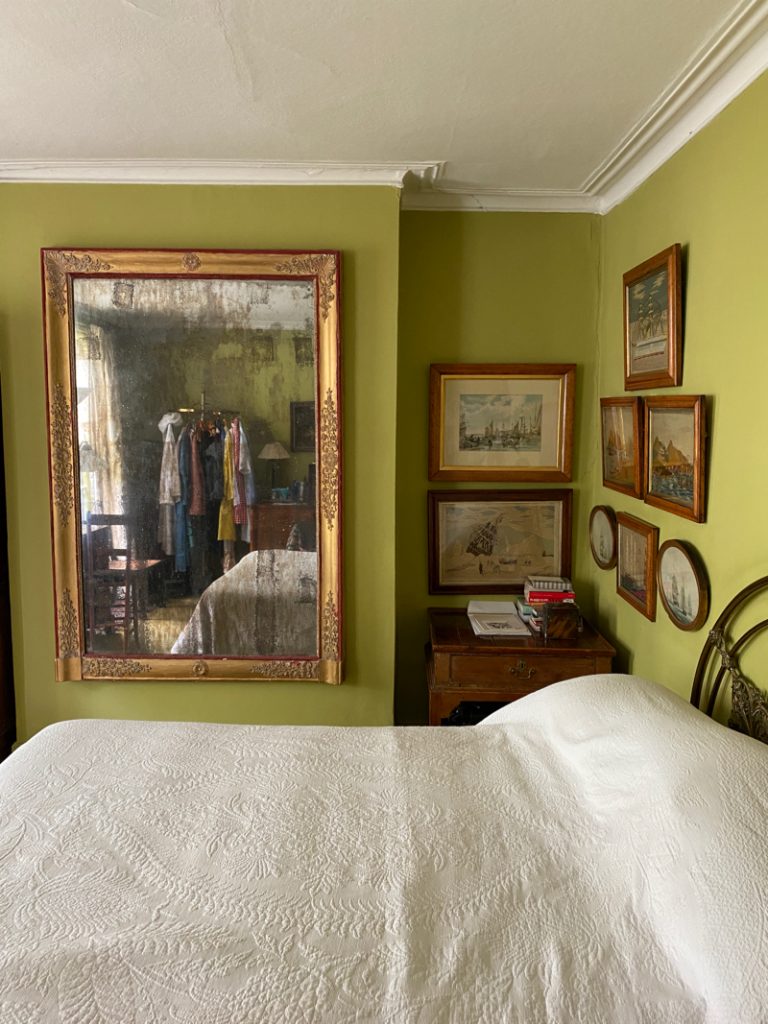
bedroom

bedroom
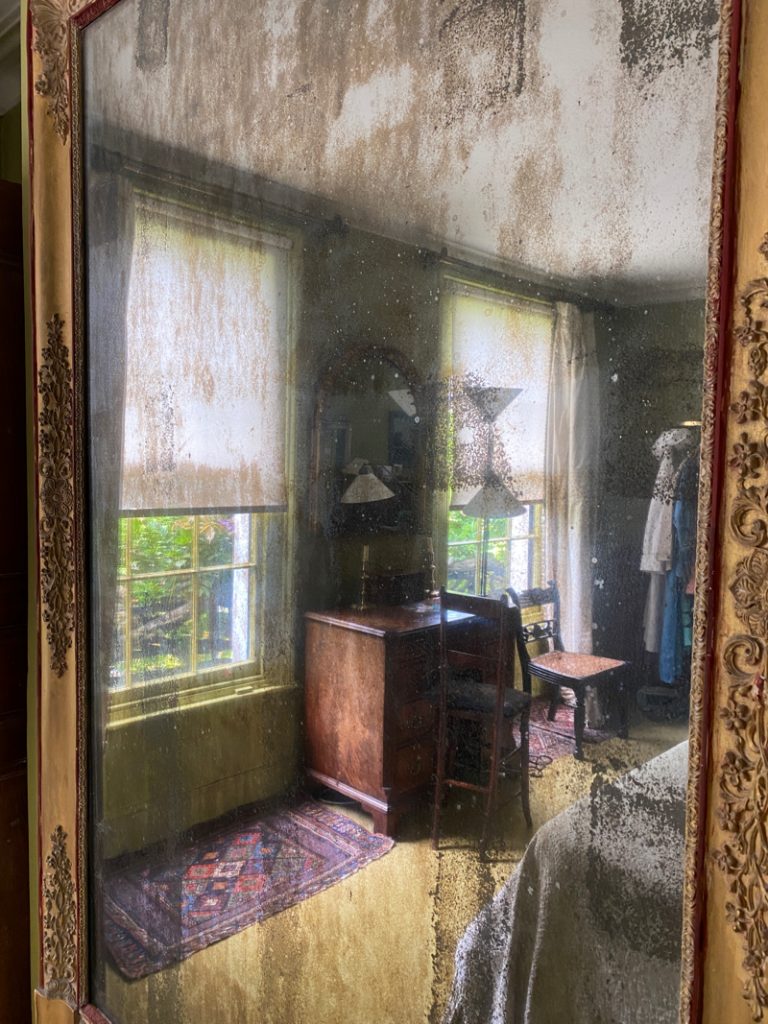
french empire mirror
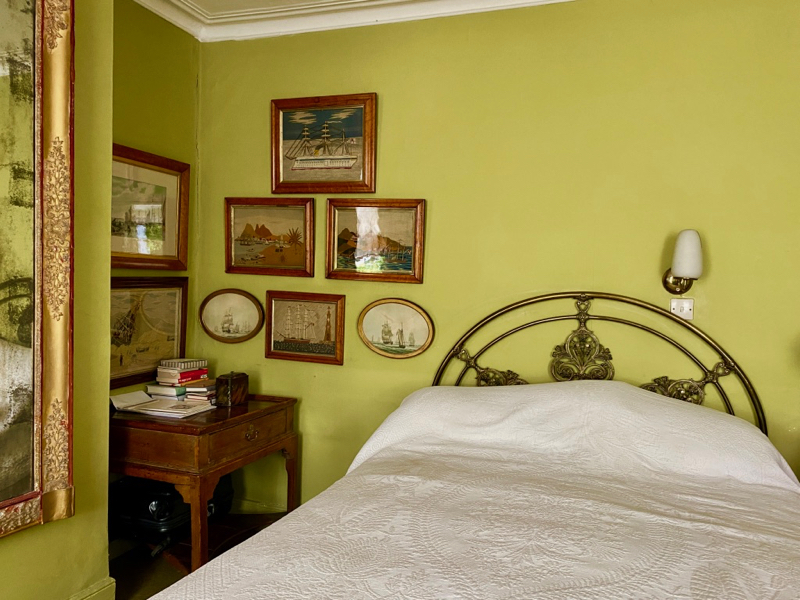
‘This is painted the way French people do it.
I think the English pick out everything in white.
Green.
It makes the room look much bigger.’

Every time we painted the place – we haven’t done it since Viv was alive – he used to say, Let’s get rid of all these pictures. and we’d take them down and sell them all.
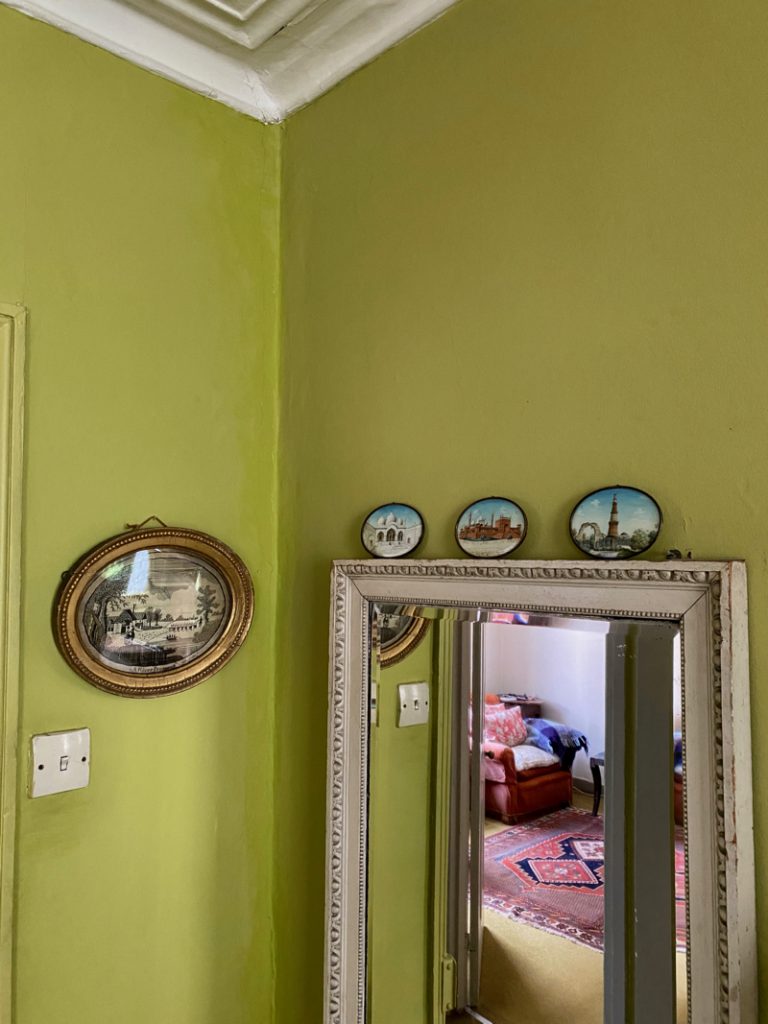
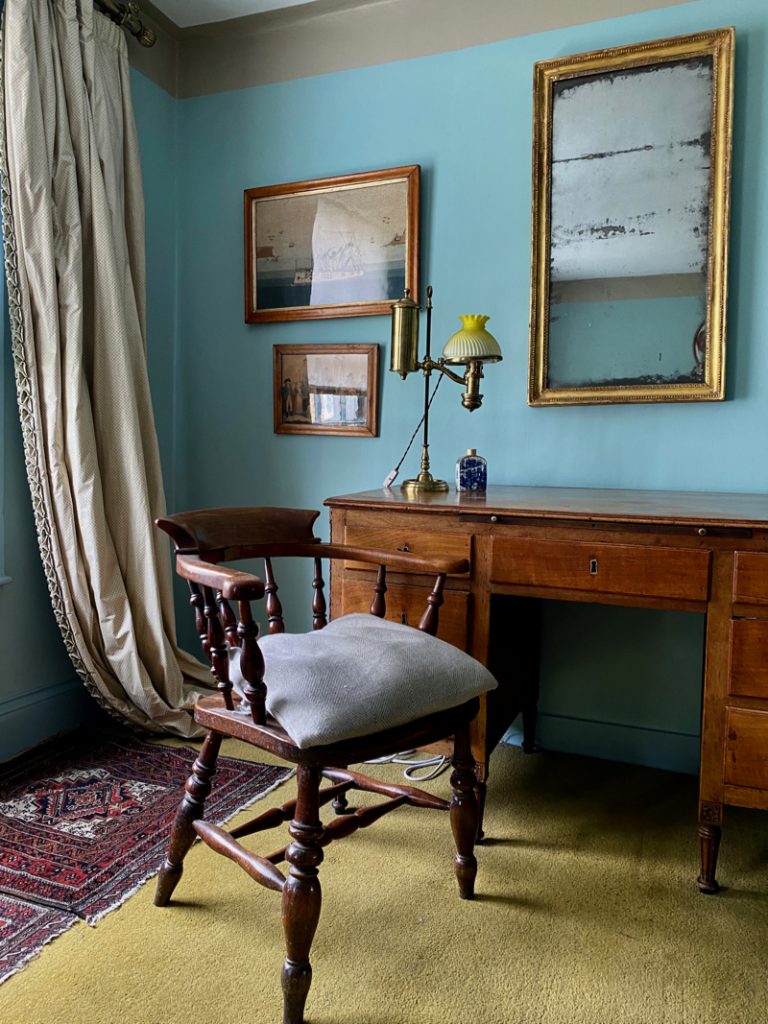
spare bedroom

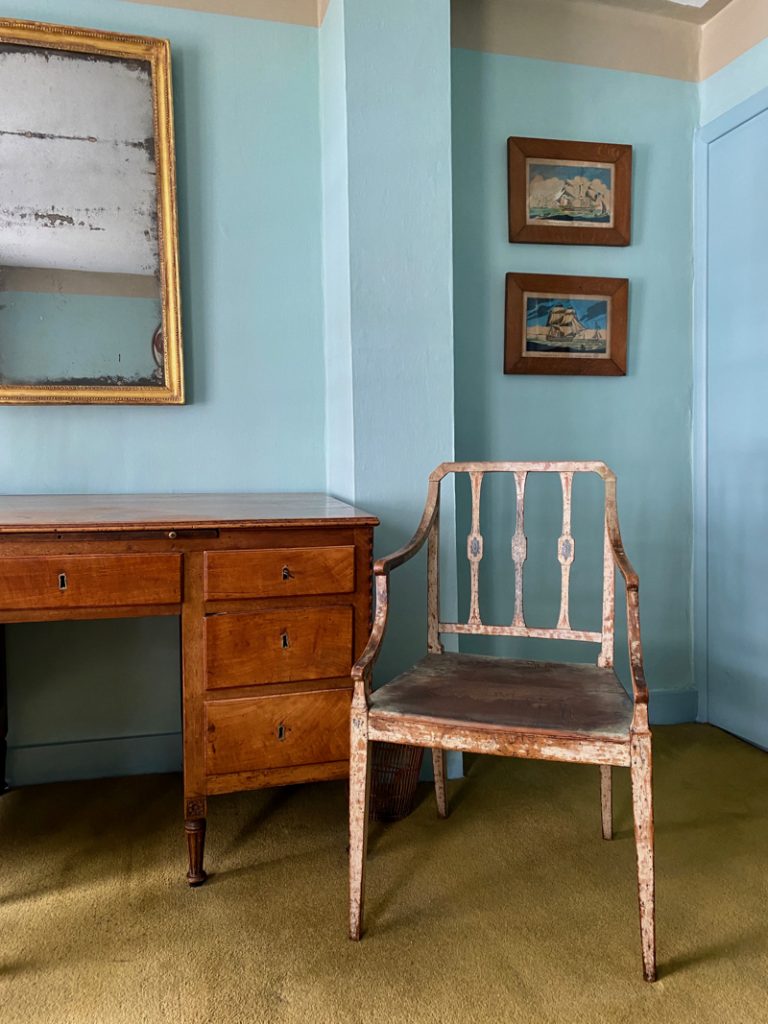

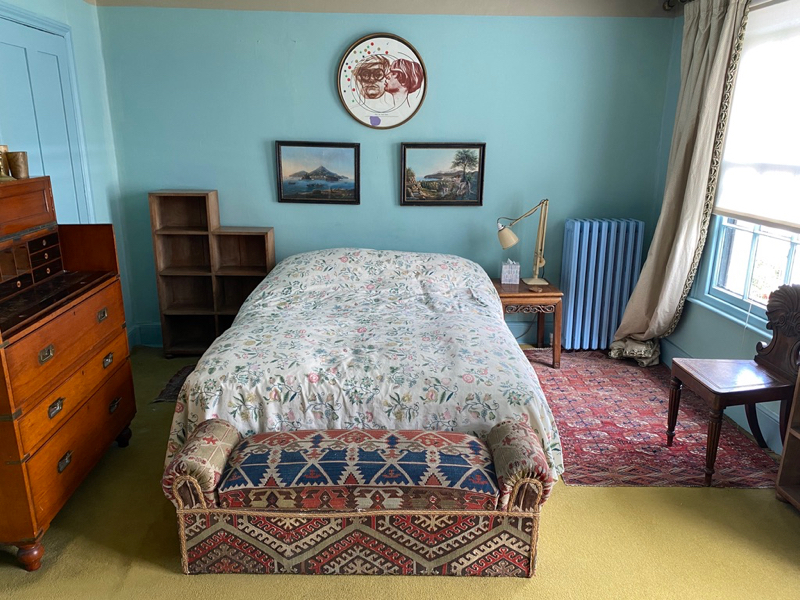
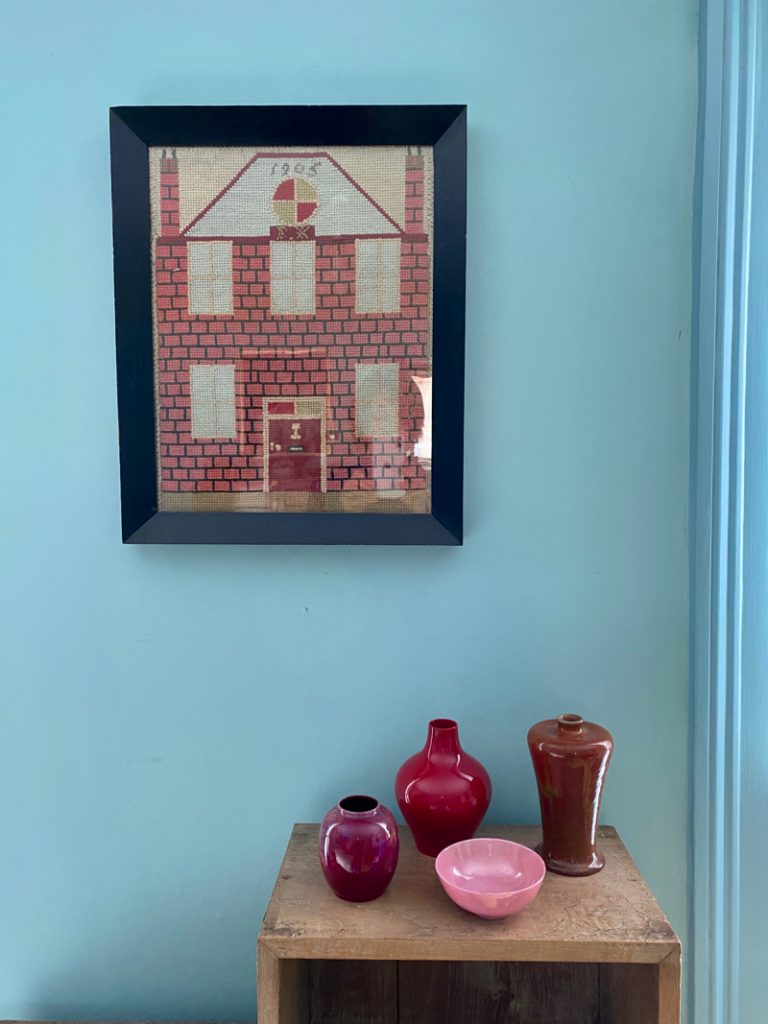
more Ruskin ware
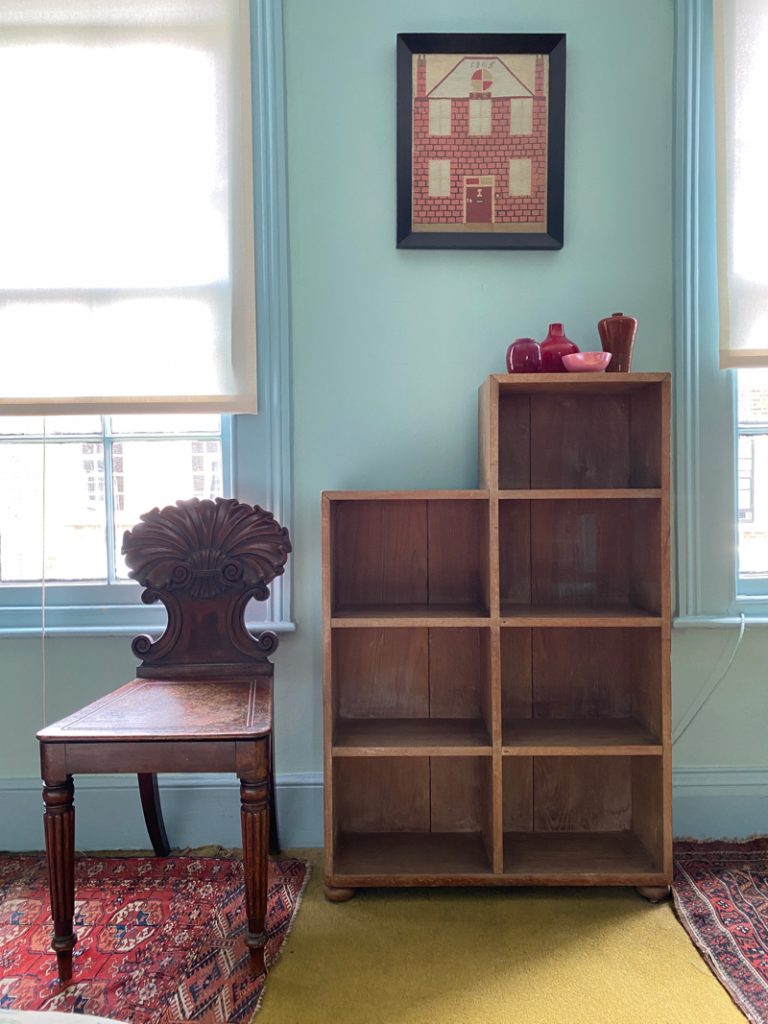
‘I realise, The World of Interiors validates you – if you’re in it.
All the time my husband was alive they asked us, and he said, I will be in it if you say nothing about me, because he couldn’t bear to read about himself. But they always wanted a story to go with it. That was Min Hogg, who was a very good customer of mine.’
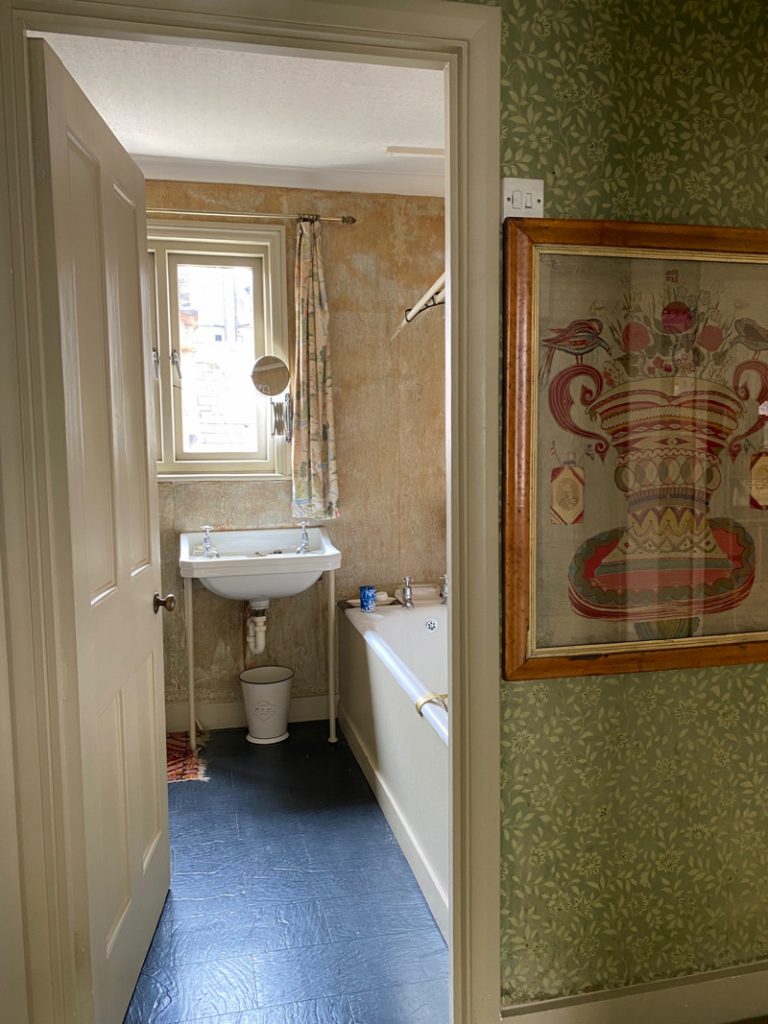
top floor bathroom
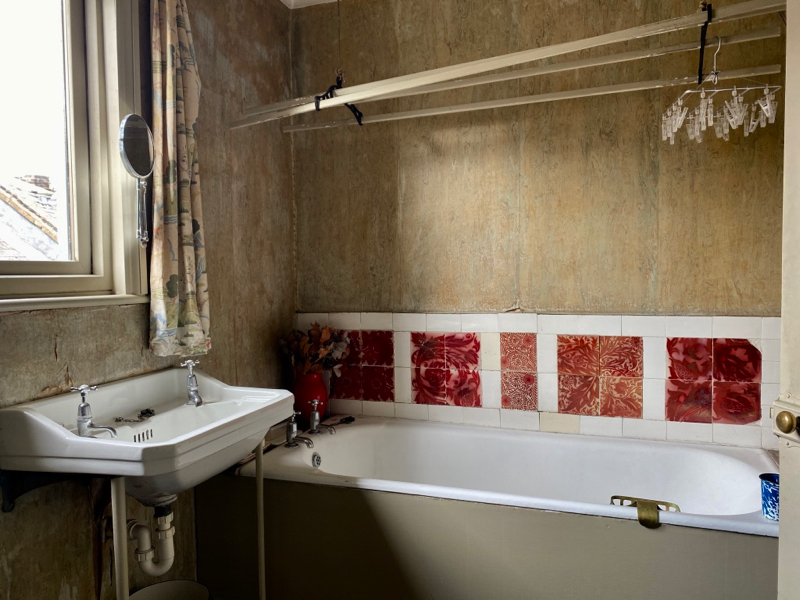
de Morgan tile splash-back
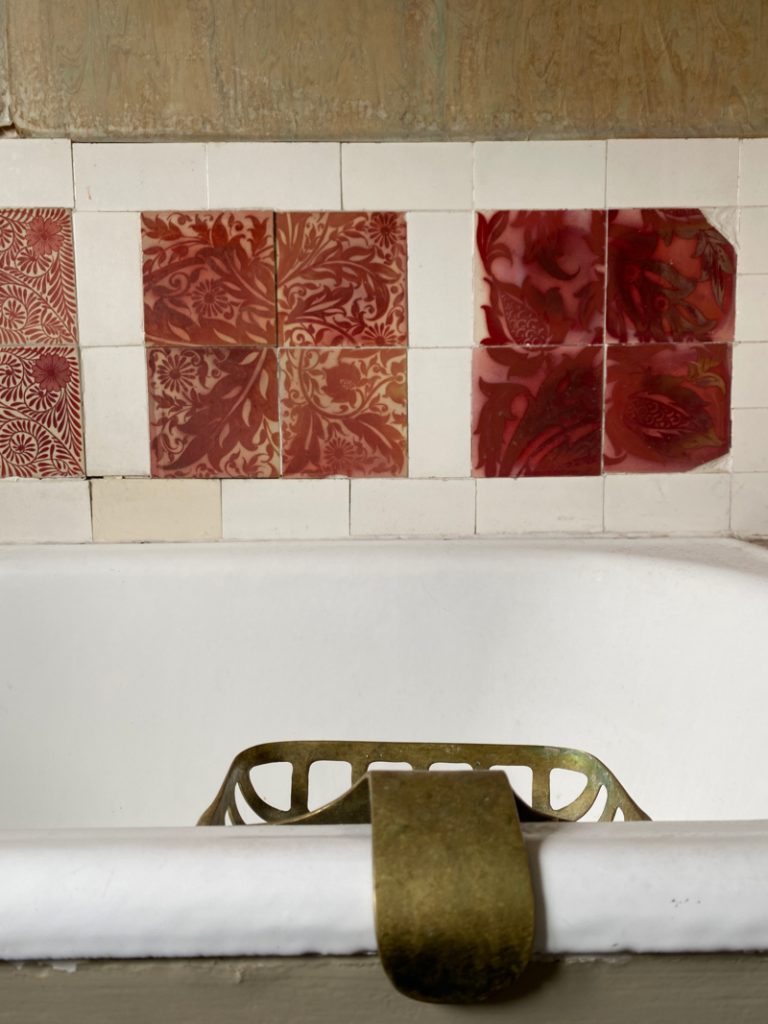
only damaged tiles were used

‘I used to collect a lot of china but Ive pulled things out and sold it.
30 years ago you had more clutter than you have now.’

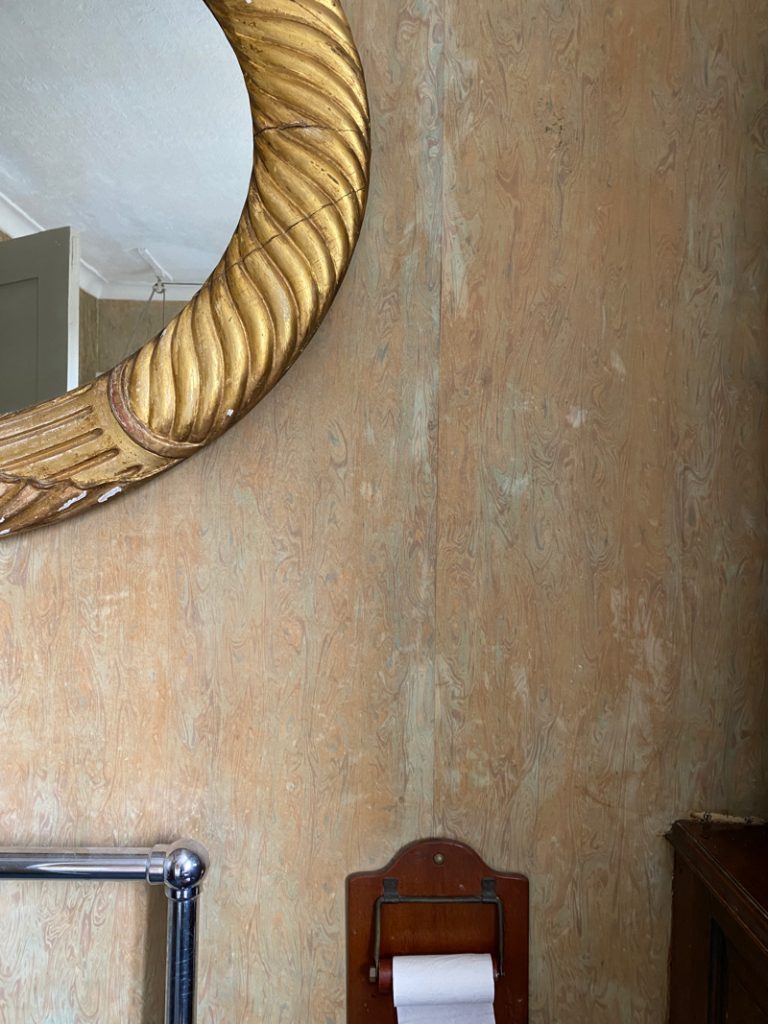
‘My long marriage wasn’t always easy – the shop kept me going and my assistants were terribly good . You’ve got to realise, however clever and successful you think you are, you make stupid mistakes. It makes you see cause and effect. It makes me realise that nothing is what it seems.’
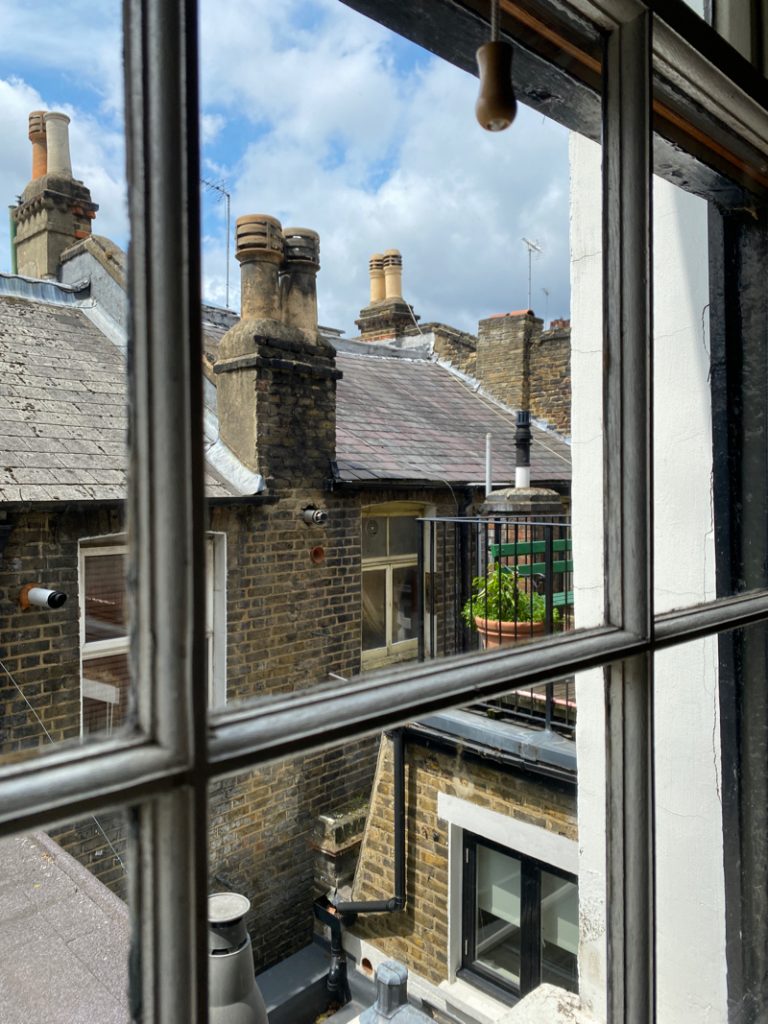
‘I’ve never been interested in the money side of it. When I go into the shop I say, That’s not interesting enough, I don’t know why I bought it, don’t put it in the front – Put it in the back!
I think when you get older, you need money more than when you are young.’
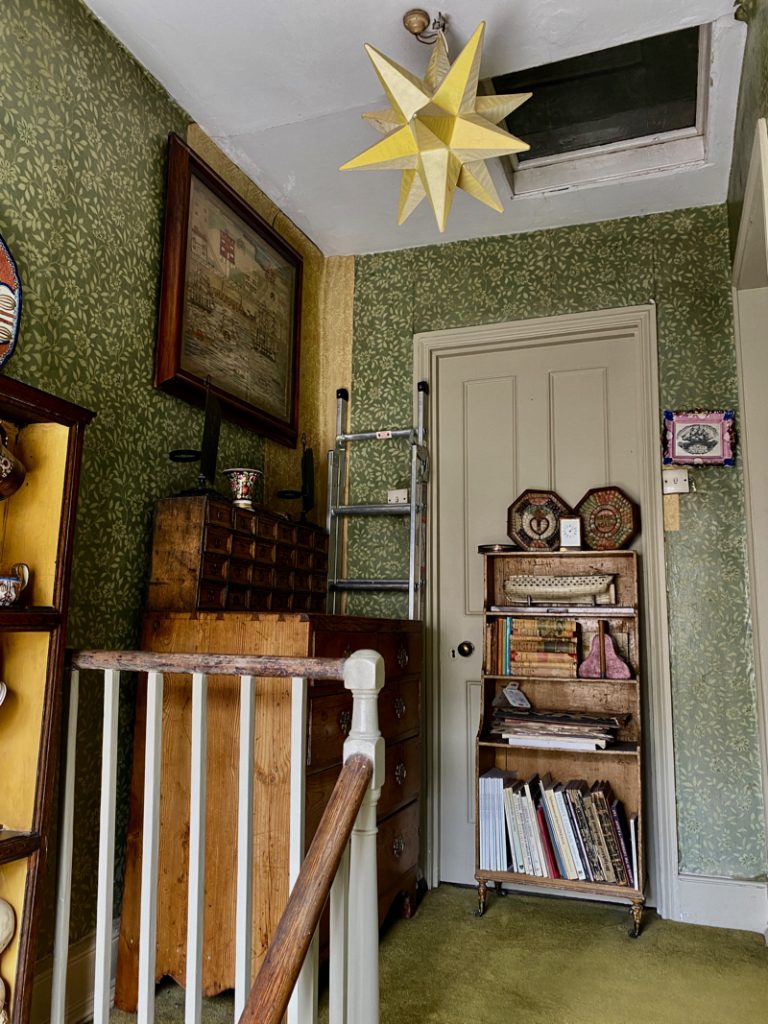
‘In those days we used to sell 40 percent to American dealers, they were the biggest dealers in the world. Then hiring became the core activity 40 years ago. What I wanted to keep were the rare things, but what people wanted to hire were the not-so-rare-things.
When I started, I had a huge collection of very rare cutlery, a better collection than the V and A. But masses of things I’ve had to get rid of – like fish eaters – that nobody gives a damn about now. People are terrible thieves nowadays tho.’

‘When the holidays came, I would decamp to our house in Sussex. I would spend 3 days there and Viv would spend 3 days there, one of them overlapping. I should get rid of it, but it’s like signing a death warrant. I’ve sold a lot of the things from that house in the shop, and I stupidly sold them for far too little – but most things go down anyway. But they’ve done their work haven’t they?’

‘In principle if something looks like a lot of money, it’s because I’ve paid a lot. When you’ve been running a shop for years you know, if someone says, This is a really nice shop, they’re never going to buy anything.
Ewan [ Ramsay-Wilson, her partner in the shop] says, Nobody wants to pay what you’ve asked; in every sale that we make there are at least 20 others when you have to come down. But I never get used to it. Thirty years ago there was a huge market in early painted furniture. A customer tried to sell me back a dresser he’d bought from us years ago – it had been a huge price, we’d never have got that now, But for a long time, if anyone came and wanted to sell me back something I’d always buy it back, and offer them a bit more.’
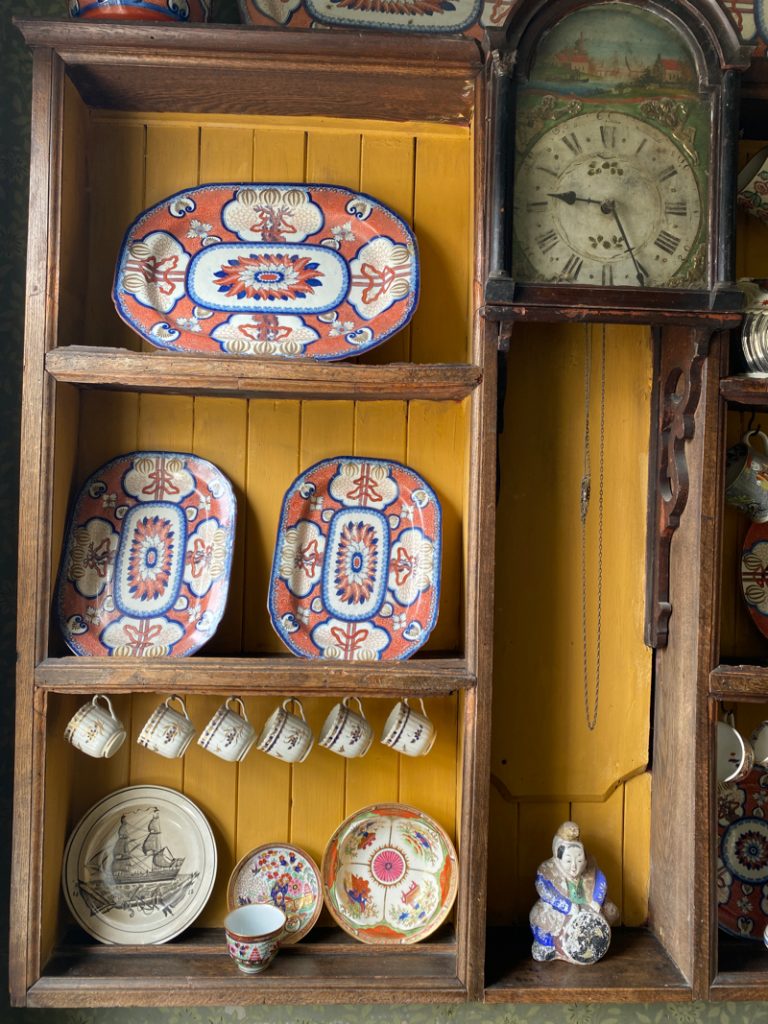
‘We got £600 for a pair of little Staffordshire birds, they were very early but they’d have been about three thousand twenty years ago.
Staffordshire’s gone down more than anything. China was dominated by very few people, there are no collectors left now.
Only decorators buy pairs of things.
Most decorators don’t like antiques, they like repro.’

‘This china is called the Dollar pattern. No one’s ever found one marked, its about 1820, its transferred and painted by hand, the orange is on top.
It’s very hard to find now.’

Very many thanks to Gretchen Andersen
All photographs copyright bibleofbritishtaste. Excerpts may be used as long as clear links are supplied back to the original authors and content.
The Lacquer Chest
75 Kensington Church Street
W8 4BG
London
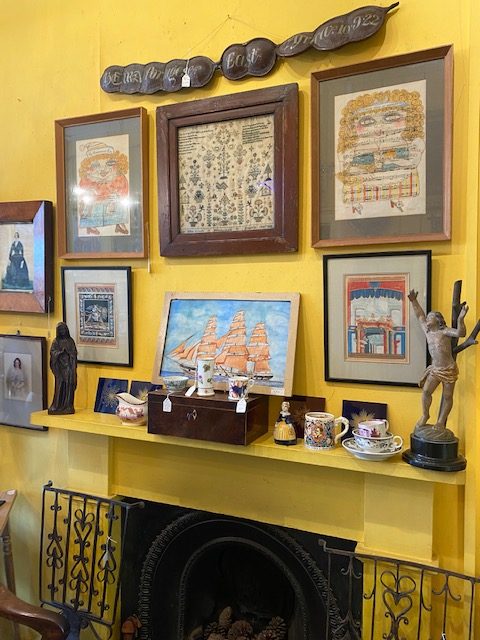
At the shop. “I’m at home having had a very exciting day buying for the shop yesterday! It involves waking and rising at 5am and staggering back at 4.15. But I found many new exciting bits for the shop.’
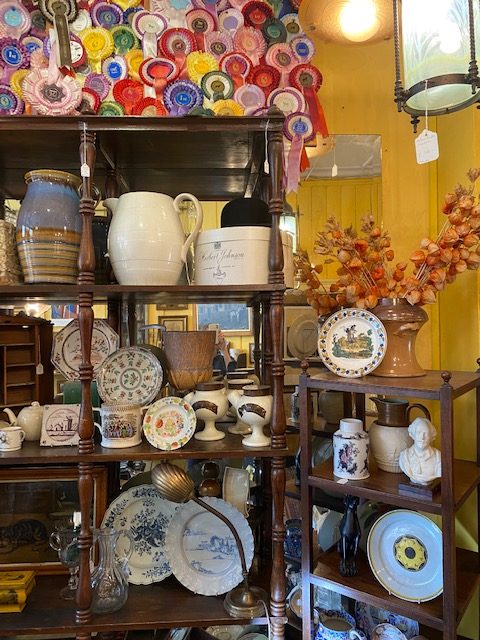
The Lacquer Chest
Located between Notting Hill Gate & High Street Kensington London Underground Stations(Central, Circle and District Lines)
Shop: 00 44 (0)20 7937 1306
Prop hire: 00 44 (0)20 7938 2070
email: info@lacquerchest.com
OPENING TIMES:
Monday to Friday 10:00 – 4:00
Saturday (shop only) 10:30 – 4:00
Sunday closed

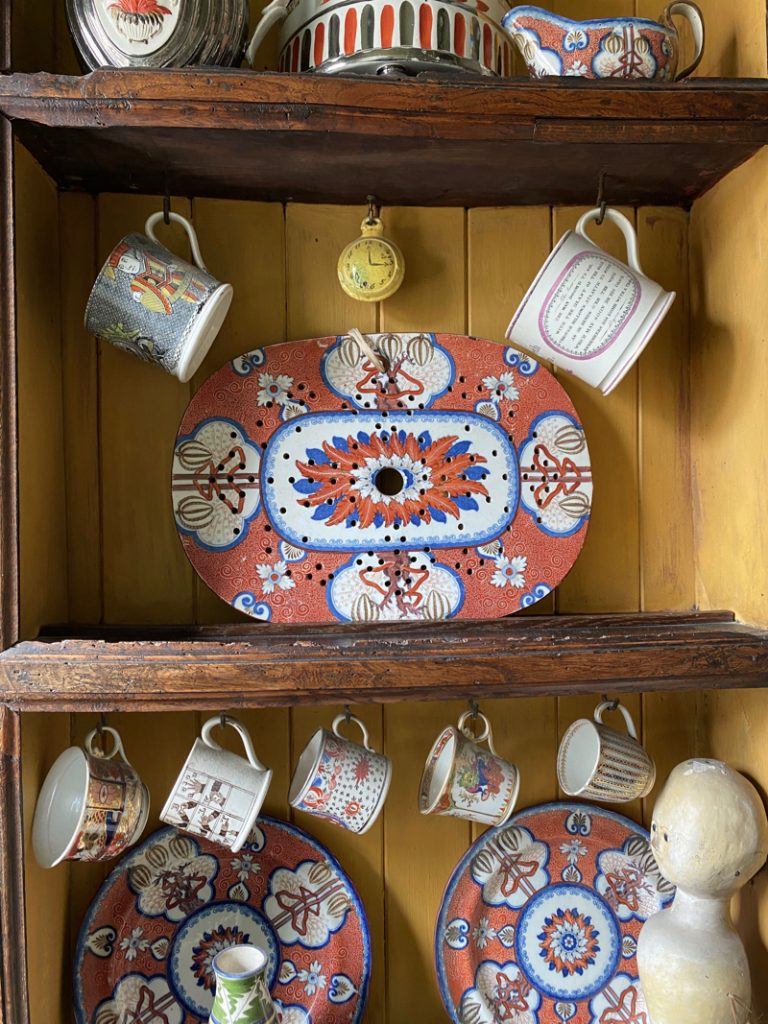
My occasional visits to the Lacquer Chest (to hire props for a small graphic design company) 35 odd years ago really formed my taste as a 20 year old forever. It really was perfect inspirational heaven!
What an interesting life and home. So nice that you found something you absolutely loved to do—and made money from it! So many people would love to have that. Love your home, too…Something interesting in every corner! Thank you for sharing.
to have really exquisite taste is a rarity
I have the “moutarde” jar of the collection on the top shelf in the kitchen. I want the others now too..
A marvellous journey through your online wonderland .
Thank you.
Amazingly your taste is my taste, I
I love the random display, well if you are blessed with good taste u can’t go wrong. Love it all…from sunny Gippsland, Australia.
just loved this home and the tangible spirit behind it. so refreshing to see an unselfconscious hard to pigeon hole, timeless interior put together seemingly haphazardly but with a gimlet, heart-trained eye. a lovely kitchen , functional but adorned beautifully with an exceptional magpie eye. and not an island in sight! yipppeee. the money we throw at kitchens these days, in the light of this article, appears something of shame and not to applaud. I really wish I knew this woman, I really wish I had known this shop. im not from London , had never wanted to be, but now I wish I was.
We miss you!!! Longing for a reason to come to London but alas a bit long in the tooth. Ben joins in Sending love and good wishes . Such happy memories.
Cheers! Judy and Ben Watson
And now, (20/9/2024), Gretchen’s home is for sale, and the homogeneous island kitchen is coming…
– the estate agents describes the house thus;-
‘Key features
‘Prime location. Unmodernised. Kensington Gardens close by. Discreet and leafy enclave.’
‘Description
‘Situated in a discreet and leafy enclave in prime Kensington, W8 sits this rare Victorian house which is in need of full refurbishment.’